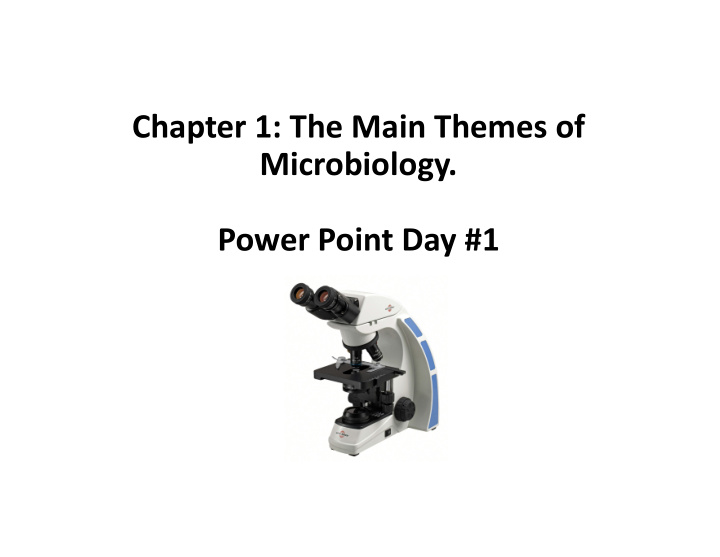



Chapter 1: The Main Themes of Microbiology. Power Point Day #1
Mic Microbio iolo logy Stu tudie ies… 1. Microorganisms – living organisms that are too small to be seen without a microscope 2. Microbes – too small to be seen without a microscope; includes all microorganisms, but also includes things that are not alive, such as viruses 3. Viruses – Non-living, microscopic, able to infect microorganisms • Considered non-living because they are not able to reproduce on their own; they first need to infect another cell so that they can use that cell’s parts to reproduce
Mic Microbio iolo logy is is imp importan ant t becau ause… • Microorganisms are EASY to study because they reproduce quickly but also DIFFICULT to study because of their small size. • The study of microbiology has led to a greater understanding of the chemistry of life/biochemistry. • This has lead to new treatments and cures for disease. • Ex. The antibiotic penicillin
Ar Archa haeba bacteri ria (anc ncient t ba bacteri ria) he helpe ped d to sha hape pe the the worl rld’ d’s ha habi bitats ts: Prokaryotic Cells (simple, unicellular) • Cells structures included a cell wall, genetic material (DNA or RNA), ribosomes • Ribosomes are the site of protein synthesis and needed to make proteins from the • genetic material Required nutrition: • Autotrophs – Make own food • Heterotrophs – Bring in food from the environment (eating) • Extremophiles live in Extreme Environment Habitats (anaerobic – does not need oxygen) • Volcanoes • Deep sea vents • Hot springs • Glaciers • Salt Mines •
Ho Hot S Spring
Deep Deep Sea ea Ven ent
Sa Salt Mi Mines
History: Many microbi biologists be believe… • Single celled organisms arose on Earth about 3.5 billion years ago • Bacteria have been on Earth 2 billion years longer than animals. • Bacteria SHOULD NOT be eliminated. • Live in its present form would not be possible with the changing of microbes in response to their changing environment over time. • Microbes are found nearly everywhere on Earth and play a central role to life on Earth. Question to ponder: What are some of the pros and cons to using antibacterial soaps, wipes, sprays, etc…
Microbes are deeply involved in the flow of energy and food through the Earth’s ecosystems. • Microbes/bacteria invented photosynthesis long before plants existed. • Bacteria are responsible for changing the atmosphere of the Earth from one without oxygen to one with oxygen. • Life as it is on Earth today would not exist if it weren’t for bacteria! • Bacteria and algae account for 70% of Earth’s photosynthesis. Algae!
Decomposition and nutrient recycling unlock chemical elements for reuse. • Many of the gases that regulate the Earth’s temperature are produced by microbes. • CO 2 (Carbon Dioxide) • CH 4 (Methane) • A large number of microbes live beneath the Earth’s crust. • When trees lose their leaves or animals in the wild die, bacteria break down their bodies and put left over, essential nutrients back into the Earth. • Microbes live in complex relationships with plants and animals. This is known as symbiosis . • Ex. Good bacteria that live in the intestines of animals allowing them to properly digest food. (Ex. Lactobacilli allow for the digestion of dairy products.)
Assignment to Recap Notes & Expand kn knowledge! Answer on separate composition paper. (1 formal bonus point for writing in complete sentences!) 15 FO FORMAL points 1. What is the difference between a microorganism and a microbe? 2. Why is a virus considered to be non-living? 3. What makes microbiology easy to study? What makes microbiology hard to study? 4. What are Archaebacteria and what have they helped to do? 5. What does it mean to be prokaryotic? 6. Prokaryotic cells lack most structures found in other cells, but they do have ribosomes. Why are ribosomes absolutely essential? 7. What is the difference between an autotroph and a heterotroph? 8. What is an extremophile? 9. How long are single-celled organisms believed to have been around? How long have bacteria believed to have been around? 10. Describe your personal opinion on the use of antibacterial products. 11. How much of the Earth’s photosynthesis is performed by bacteria and algae? 12. What two gases help to regulate the Earth’s temperature? 13. What is symbiosis? Give an example of how symbiosis can be beneficial. 14. If a person lacks the bacteria lactobacilli in his/her gut, what disorder will result? 15. Looking ahead to the next round of notes: Use the internet to research foods that microorganisms, such as bacteria, help to make. Make a list!
Recommend
More recommend